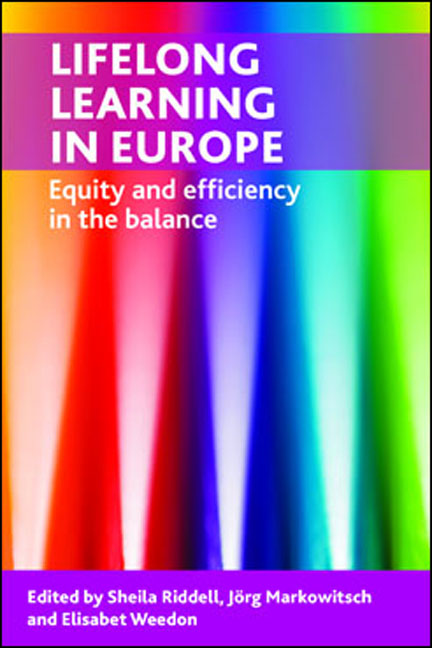Book contents
- Frontmatter
- Contents
- List of figures, tables and case studies
- Notes on contributors
- List of contributors, by country, to the EU Sixth Framework Project ‘Towards a Lifelong Learning Society in Europe: The Contribution of the Education System’ (LLL2010)
- one Lifelong learning and the generation of human and social capital
- two Lifelong learning and the wider European socioeconomic context
- three Neoliberal and inclusive themes in European lifelong learning policy
- four Formal adult education in the spotlight: profiles, motivations and experiences of participants in 12 European countries
- five The sociodemographic obstacles to participating in lifelong learning across Europe
- six The qualification-providing enterprise? Support for formal adult education in small and medium-sized enterprises
- seven Reducing or reinforcing inequality: assessing the impact of European policy on widening access to higher education
- eight Conclusion: the role of lifelong learning in reducing social inequality at a time of economic crisis
- Technical annex to Chapter Four
- Glossary of terms and abbreviations
- Index
five - The sociodemographic obstacles to participating in lifelong learning across Europe
Published online by Cambridge University Press: 01 September 2022
- Frontmatter
- Contents
- List of figures, tables and case studies
- Notes on contributors
- List of contributors, by country, to the EU Sixth Framework Project ‘Towards a Lifelong Learning Society in Europe: The Contribution of the Education System’ (LLL2010)
- one Lifelong learning and the generation of human and social capital
- two Lifelong learning and the wider European socioeconomic context
- three Neoliberal and inclusive themes in European lifelong learning policy
- four Formal adult education in the spotlight: profiles, motivations and experiences of participants in 12 European countries
- five The sociodemographic obstacles to participating in lifelong learning across Europe
- six The qualification-providing enterprise? Support for formal adult education in small and medium-sized enterprises
- seven Reducing or reinforcing inequality: assessing the impact of European policy on widening access to higher education
- eight Conclusion: the role of lifelong learning in reducing social inequality at a time of economic crisis
- Technical annex to Chapter Four
- Glossary of terms and abbreviations
- Index
Summary
Introduction
This chapter analyses the barriers that potential participants in lifelong learning face when they consider returning to education. There are considerable differences between people in relation to the extent to which they participate in learning after their initial compulsory education. Some engage in learning to improve their opportunities in the labour market, while others do it for personal fulfilment or for social and civic reasons. Some people do not re-enter the education system after their experience of initial education. As mentioned in Chapter One, the need for ongoing engagement in education has become a central focus for policymakers through the lifelong learning agenda. Lifelong learning is seen as a means of enhancing the human capital of the workforce but also as a vehicle for promoting social inclusion by providing individuals with the relevant skills to participate in the labour market. Identifying reasons for non-participation and barriers to participation in learning is therefore of great importance. This chapter examines barriers to participation by comparing a target group of learners and a control group of non-learners. The aim is to identify the structural features that may deter individuals from obtaining additional qualifications, and how these features vary in relation to particular countries and groups of countries. Of prime interest is the way in which social structures shape a person's capability to participate.
Conceptual framework
Rubenson and Desjardins (2009), in their review of the comparative literature on barriers to participation, note that most analysts draw on the classification of barriers developed by Cross (1981). The types of barrier identified by Cross are situational (that is, relating to job, family or household), dispositional or institutional. According to Rubenson and Desjardins, the main problem with the raft of studies on barriers to participation is that they tend to overemphasise individual factors and underemphasise the salience of structural factors, such as an individual's position in the socioeconomic hierarchy and the way this affects all aspects of their world view. Drawing on the work of Bourdieu (1990) and his notion of habitus, they argue that structural factors are centrally involved in individual motivation, since a person's sense of their ability to actively construct their life is shaped by the social, economic and cultural resources that they are able to mobilise.
- Type
- Chapter
- Information
- Lifelong Learning in EuropeEquity and Efficiency in the Balance, pp. 87 - 102Publisher: Bristol University PressPrint publication year: 2012



